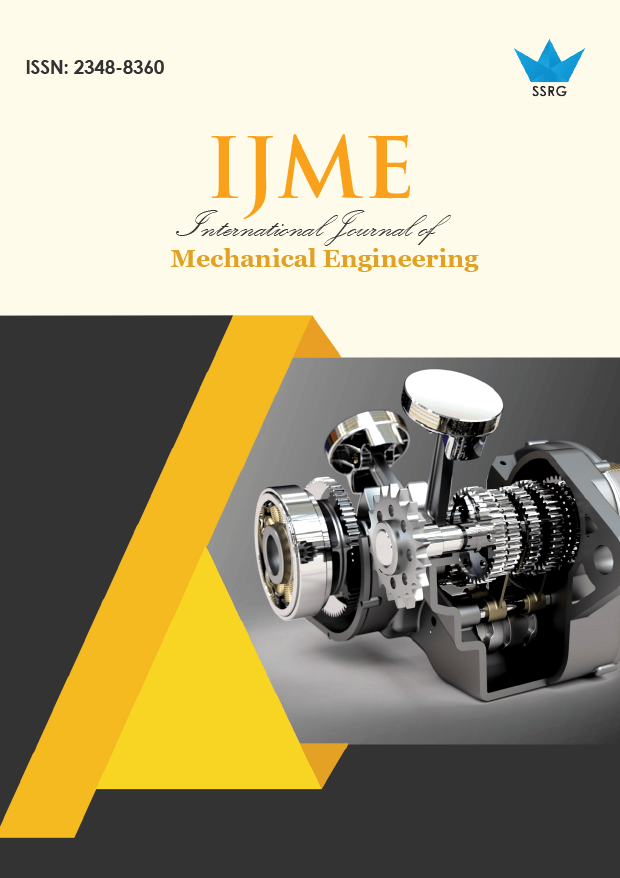Flow Simulation of Recycled Concentric Tube Heat Exchanger for Raw Milk Micro-Scale Pasteurization

| International Journal of Mechanical Engineering |
| © 2016 by SSRG - IJME Journal |
| Volume 3 Issue 5 |
| Year of Publication : 2016 |
| Authors : M. D. Bako, M.S. Abolarin, A. Nasir, A. Babawuya, A. Mohammed |
How to Cite?
M. D. Bako, M.S. Abolarin, A. Nasir, A. Babawuya, A. Mohammed, "Flow Simulation of Recycled Concentric Tube Heat Exchanger for Raw Milk Micro-Scale Pasteurization," SSRG International Journal of Mechanical Engineering, vol. 3, no. 5, pp. 1-6, 2016. Crossref, https://doi.org/10.14445/23488360/IJME-V3I5P101
Abstract:
Heat exchanger, a versatile equipment which finds its application in both industrial and domestic environment is simulated with the principle of recycled heat transfer technique over a short concentric tube. The simulation of the heat exchanger was to ascertain its viability of solving the problem of portability, cost effectiveness and micro-scale pasteurization of milk product. This new concept is a Short Tube-Low Temperature, Long Time Pasteurization (ST-LTLT) or Cycle Pasteurization. The simulation provided 62.88oC and 61.12oC average temperature of liquid and solid respectively on iterative programme or cycles/minutes which provided an obvious plat form for the feasibility of micro-scale pasteurization with cost-effectiveness and portability. The exhibited behavior of turbulent velocity, pressure drop and density were in conformity with theory of pasteurization. Indeed, this concept if successful will complement the existing conventional methods of arranging plates and long concentric pipes for High Temperature Short Time (HTST) and Low Temperature Long Time (LTLT) which is characterized with the challenge of microscale pasteurization. The study of transient heatanalysis of the heat exchanger to guide the design and construction process precedes this paper.
Keywords:
pasteurization, tube heat exchanger, cycle pasteurization
References:
[1]. Lienhard, J.H., (2005). A Heat Transfer Textbook, Prentice – Hall
[2]. Mills A. F. (1992). Basic and Mass Heat Transfer, IrwiaTomaka Press (Ormond Bench, F. L. USA).
[3] Milind, V.R., Madhurkar S., T., Water-to-water heat transfer in tube-tube heat exchanger.Exprimental and analytic study, Applied Thermal Engineering, Volume 26, Issues 17-18, December 2005, pp 2715-2729
[4] Serth, R.W. (2007). Process Heat Transfer Principles and Applications, Elsevier.
[5] World Health Organization (2006), Food Safety a center for disease control, morbidity weekly reprt march 2007.
[6] Staal, S. I., Delgado, C, Baltenweck, I., Krusha, R., (2000). Spatial aspects of producer milk price formation in Kenya : A joint household – GIS approach. A contributed paper at the international Association of Agricultural Economists meetings. Berlin, Germany
[7] Hand, J.W. (1998), Removing Barriers to the Use of Simulation in the Building Design Professions, PhD Thesis, University of Strathclyde, Glasgow UK.
[8] Bazjanac, V. and Crawley, D.B. (1997). „The Implementation of Industry Foundation Classess in Simulation Tools for the Building Industry‟, Proc. Building Simulation ‟97,(1)203 – 210. Int. Building Performance Simulation Association, Prague Czech Republic.
[9] Clarke, J.A., Hand, J.W., Strachan, P.A., and MacRandal, D.F. (1995). „The Development of an Intelligent, Integrated Building Design System within the European COMBINE Project‟ Proc. Building Simulation ‟95, 444- 453 Int. Building Performance Simulation Association, Madison USA.
[10] ASHRAE (1998), Standard Method of Test for the Evaluation of Building Energy Analysis Computer Programs: ASHRAE Standard 140P, Working Draft 98/2, American Society of Heating, Refrigerating and Air- Conditioning Engineers, Atlanta USA.
[11] Ugwu E. (2012). Maizube Farms Nig. Ltd, Minna, Niger State. Km 26, Minna-Bida Road, P.M.B. 1152, Minna, Niger State.

 10.14445/23488360/IJME-V3I5P101
10.14445/23488360/IJME-V3I5P101